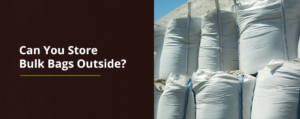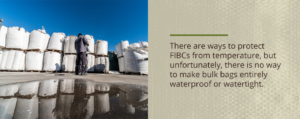
Flexible intermediate bulk containers (FIBCs) are highly useful to various industries. They’re durable, reusable, recyclable and excellent for a broad range of purposes. Most of them are made of strands of plastic and polypropylene woven tightly together, which creates a resilient and flexible fabric. Each bag is strong enough to hold upwards of 2,000 pounds of product and is light enough not to add any unnecessary weight. While they are incredibly strong, the temperature can affect them in different ways.
You may assume it’s perfectly fine to store bulk bags outdoors, as they’re meant to take on a lot of wear and tear. However, weather conditions can leave your products susceptible to damage. If you have to stock your bags in an outdoor area temporarily, there are several ways you can mitigate the effects of the elements.
Can Bulk Bags Be in High Temperatures?
High temperatures can affect the overall strength of FIBCs. While polypropylene and plastic can withstand a lot of wear and tear, exposure to heat can loosen the molecules in the materials. As the particles move, the bag weakens and loses its tensile strength, making it less effective. The bag can begin degrading at temperatures as low as 70 degrees Fahrenheit, and with added heat, it becomes weaker and much more prone to significant damage, such as tearing.
While this is the case for regular FIBC bags and higher temperatures, you can strengthen them to resist molecular shifting, even in hotter conditions. Depending on the material you intend to store and how much heat it holds, you can protect your bags with an inner liner. These liners are typically made of polyethylene, as this material is less affected by high temperatures. It begins to get soft at about 195 degrees Fahrenheit, but it’s best to ensure whatever you put into the liner is under 170 degrees.
If you want to safeguard your bulk bags to resist higher levels of heat for filling purposes, you may wish to use high-temp polypropylene liners. They’ll protect your bags up to 295 degrees, an excellent choice for any business with products that reach high temperatures. However, keep in mind that inner liners won’t protect the exteriors of the bags from heat and UV rays. For that, you’ll need to cover the FIBCs with a protective material, preferably one that won’t trap heat.
Can Bulk Bags Be in Low Temperatures?
Low temperatures can affect bulk bags just as significantly as high temperatures. If you live in an area that experiences particularly harsh winters, storing your FIBCs outside may affect their durability. Cold temperatures, rain and snow can cause the polypropylene material to deteriorate, especially if it’s been sitting outside for an extended period, exposed to adverse weather conditions and UV rays. Ultimately, you should store bulk bags in temperate areas with cool, dry conditions for the best results and to extend their longevity.
There is no correct or particularly effective way to protect bags from low temperatures and winter weather. You can help guard the materials inside by adding a polyethylene or liquid liner, as well as using bags with an external coating. They won’t provide full waterproofing or keep the materials warm, but they will help keep your stored products safe. If you have to resort to outdoor storage for bulk bags in winter conditions, you’ll need to cover them with waterproof material and try to move them inside as quickly as possible.
Are Bulk Bags Waterproof?
While FIBCs are durable and made from tightly woven materials to ensure your products stay safe in the bag, they are not waterproof or watertight. Even if the bag has a polypropylene laminate coating on the inside or outside, it isn’t resistant to water. It works as a moisture barrier for the items you have stored inside and will reduce the amount of fine-grain material that can leak out of the bag. But water will still penetrate through the fabric.
There are ways to protect FIBCs from temperature, but unfortunately, there is no way to make bulk bags entirely waterproof or watertight. But you can use one of several items to help limit the amount of moisture that seeps through the fabric. For one, you can add fitted polyethylene liners to the interior of your bulk bags. They’re also frequently referred to as poly-liners and are made of a flexible plastic material. While they add an improved defense against moisture penetration, they still cannot ensure the bags will be waterproof.

There’s a second form of bulk bag insert called a liquid liner, which is used for shipping and storing liquids. These types of barriers come in a rectangular shape so that they form-fit to the bag. They work excellently for containing fluids. While they could certainly help create a protective barrier between your products and environmental moisture, they do not make bulk bags watertight or waterproof.
The Best Ways to Protect Your Bags
If you absolutely must store your bulk bags outdoors, there are several ways you can mitigate the effects of the elements while making room in an indoor space:
- Use new coated bags: If you have to store materials outdoors for a time, use newer bags. They’re less likely to have any small tears that could allow water through and have a tighter weave than those with more wear. Also, the coating will help the fabric resist the external effects of the weather.
- Insert a liner: There are multiple kinds of liners available to insert into your bags. They’ll help with reducing the amount of moisture that reaches your products and act as a secondary barrier.
- Choose bags with partially closed tops: Bulk bags come in several designs, including those with spout and duffle tops, which you can secure closed. While the tops don’t make the bags waterproof or temperature resistant, they provide added coverage as compared to the open-top style.
- Cover the bags with waterproof material: One of the best ways you can protect your bulk bags and the contents they hold is by covering them with a fitted tarp or another water- and weather-resistant material. By surrounding the bags, the outside fabric will take the brunt of the weather and reduce the amount of moisture that reaches them.
- Find an indoor space as soon as possible: While these solutions are helpful, they aren’t foolproof, and they’re temporary at best. The longer your bags stay in outdoor conditions, the faster they’ll wear, putting your products at risk. Try to find an indoor storage space as soon as possible, even if it’s another temporary solution.
Get Your Bulk Bags From Midwestern Bag and Supply
At Midwestern Bag and Supply, we understand that you need reliable, quality bulk bags. We design and manufacture FIBCs and related accessories to suit the requirements of many industries and professions, from classic designs to custom orders. With distribution centers across the country and a team of qualified professionals, we can help you find the perfect bulk packaging solution.
Choose Midwestern Bag for your bulk bag supply needs. For more information about our products and services, feel free to contact us or request a quote.



 Copyright © 2025 Midwestern Bag. All Rights Reserved.
Copyright © 2025 Midwestern Bag. All Rights Reserved.